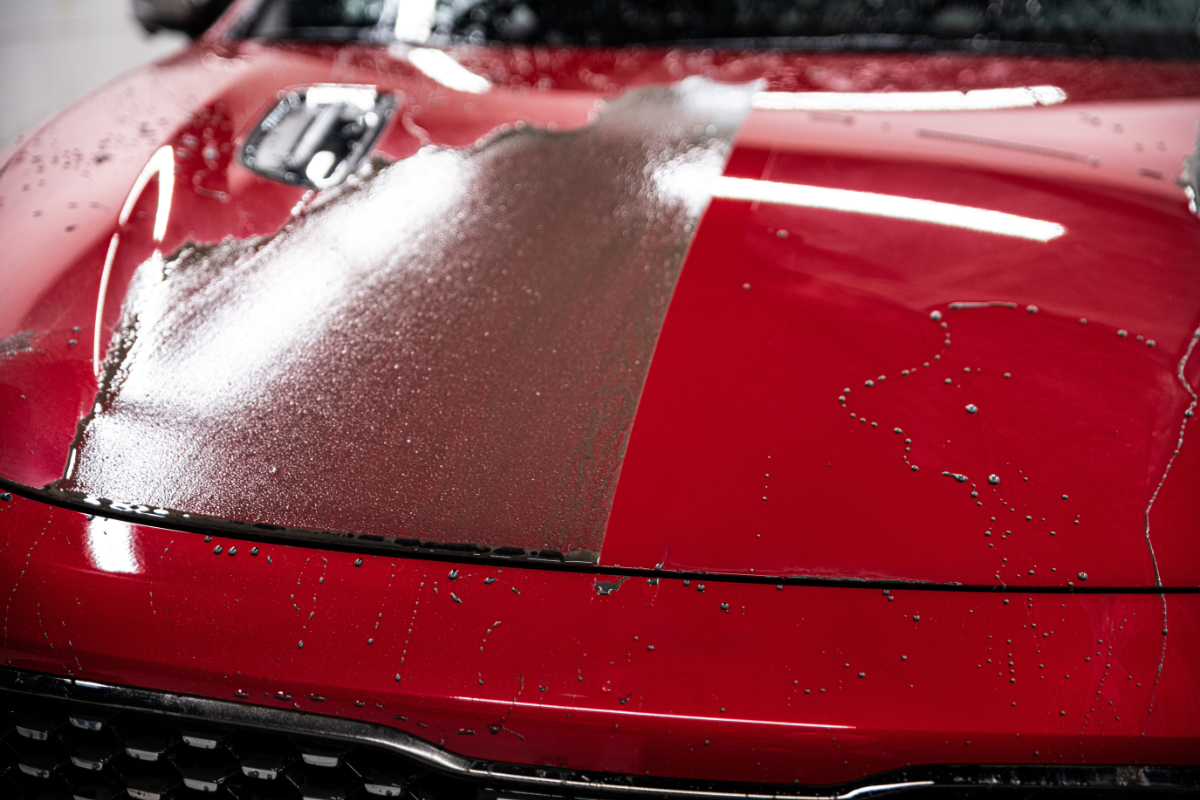How Ceramic Coating Maintains Your Car's Paint Like a Pro
Ceramic coating has emerged as a favored technique for shielding automobile paint, using a sophisticated remedy that combines sturdiness with aesthetic conservation. By developing a robust chemical bond with the automobile's factory coating, this innovative modern technology safeguards against ecological hazards such as UV radiation and corrosive compounds. The advantages extend past mere defense; with hydrophobic homes, ceramic coatings streamline upkeep and improve the automobile's look. As we discover the details of this process, it becomes evident that understanding its application and care is important for maximizing its advantages-- yet many continue to be uninformed of the essential steps involved.
What Is Ceramic Coating?
Ceramic layer is an advanced protective remedy that boosts the resilience and appearance of automotive paint. This innovative technology entails using a liquid polymer to the external surface areas of an automobile, which chemically bonds with the manufacturing facility paint - ceramic coating. The outcome is a robust, clear layer that offers outstanding resistance to environmental pollutants and physical damages
Normally composed of silicon dioxide (SiO2), ceramic layers give a hydrophobic impact, permitting water to bead up and roll off surface areas, therefore lowering the buildup of dust and gunk. Unlike standard waxes and sealers, which need constant reapplication, ceramic finishings can last for several years when correctly preserved.
The application procedure requires precise preparation of the vehicle's surface, including thorough washing, purification, and brightening to guarantee optimum bond. Following this, the ceramic coating is meticulously used, typically calling for details treating times to attain the desired degree of hardness and protection.
Benefits of Ceramic Covering
The benefits of using a ceramic layer to vehicle paint are many and substantial. Largely, ceramic finishes use boosted protection versus ecological impurities such as UV rays, bird droppings, tree sap, and road gunk. This safety layer lowers the likelihood of paint damage, therefore maintaining the car's aesthetic appeal and value over time.
Furthermore, ceramic finishes are hydrophobic, meaning they repel water and make it less complicated to clean the vehicle. This function lessens the buildup of dust and grime, enabling for less complex upkeep and less frequent washing. The smooth, glossy finish achieved through ceramic application further enhances the auto's appearance, leading to a showroom-like sparkle.
The longevity of ceramic finishes is a significant advantage; they can last for numerous years with appropriate care, supplying a cost-effective solution for long-lasting paint defense. Generally, the advantages of ceramic layers considerably raise the maintenance and long life of an automobile's paintwork.
How Ceramic Layer Works
A ceramic coating features via a chemical polymer process that bonds with the automobile's navigate to this site factory paint. This sophisticated coating is made up of silicon dioxide (SiO2) and various other nanoparticles, which develop a durable layer externally of the vehicle. When used appropriately, the ceramic finishing creates a covalent bond with the paint, resulting in a protective layer that is both hydrophobic and oleophobic.
This one-of-a-kind home allows water and pollutants to grain up and roll off the surface, lessening the adherence of dirt, gunk, and various other pollutants - ceramic coating. The ceramic finishing likewise uses improved UV defense, preventing the paint from oxidizing and fading because of long term sun direct exposure. Additionally, its scratch-resistant nature supplies a powerful obstacle versus small abrasions, making it particularly useful for maintaining the visual appeal of the car
In addition, the covering's high gloss coating boosts the paint's reflective top qualities, giving the vehicle a polished look. Unlike standard wax or sealants, which call for frequent reapplication, ceramic coverings can last for a number of years, supplying a lasting solution for paint preservation. This innovative technology guarantees that your automobile stays in beautiful condition, improving its overall value and appearance.
Application Process Explained

When the surface is tidy and smooth, it is critical to inspect for any imperfections such as scratches or swirls. These must be dealt with through polishing, as the ceramic covering will secure in any type of flaws existing. After polishing, the car must be cleaned down with an isopropyl alcohol service to get rid of any type of staying oils or deposits.

Upkeep Tips for Longevity
What steps can be taken to ensure the longevity of a ceramic layer? Normal upkeep is vital for preserving the stability and look of your lorry's ceramic coating.
Second, utilize a soft microfiber towel for drying to protect against any type of water spots. It's advisable to use the two-bucket technique during cleaning-- one for soap and one more for rinsing-- to decrease contamination.
Third, apply a maintenance spray or booster especially created for ceramic coatings every couple of months (ceramic coating). This assists bring back hydrophobic properties and enhances the coating's safety layer
In addition, stay clear of revealing your lorry to extreme chemicals or rough products, as they can jeopardize the layer's longevity. Auto parking in shaded areas or using an auto cover can shield the surface from UV rays and ecological pollutants, additionally prolonging the life of Visit This Link your ceramic finishing. By adhering to these upkeep suggestions, you can guarantee that your ceramic finish continues to be effective and aesthetically appealing for several years to come.
Final Thought
In recap, ceramic covering offers as an extremely efficient service for protecting automobile paint. With proper application and maintenance, ceramic coatings provide long-lasting benefits, ensuring that vehicles continue to be in optimum problem over time.
Comments on “Get advanced paint protection with ceramic coating.”